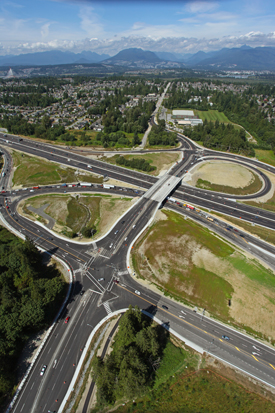A Cross-Canada Series
EVENT: Two-Day Seminar
 The 2017 Edition of TAC’s Geometric Design Guide for Canadian Roads provides guidance to planners and designers in developing design solutions that meet the needs of a range of road users while addressing the context of local conditions and environments. Design guidelines are included for freeways, arterials, collectors, and local roads, in both urban and rural locations as well as for integrated bicyclist and pedestrian design.
The 2017 Edition of TAC’s Geometric Design Guide for Canadian Roads provides guidance to planners and designers in developing design solutions that meet the needs of a range of road users while addressing the context of local conditions and environments. Design guidelines are included for freeways, arterials, collectors, and local roads, in both urban and rural locations as well as for integrated bicyclist and pedestrian design.
This two-day seminar provided new designers with an overview of the principles of the geometric design included in the 2017 TAC Geometric Design Guide for Canadian Roads. It covered both the urban and rural design environments with an emphasis on considering risk management, road user needs, and road user limitations in the design process.
Outline
- Foundation principles
- Overview of design challenges faced by designers
- Overview of design domain concept
- Key design controls including human factors
- Design classification
- Importance of design consistency
- Alignment
- Horizontal and vertical alignment elements
- Safety considerations
- Superelevation, grades, and drainage
- Truck climbing and passing lanes
- Truck escape ramps
- Cross section
- Cross section elements
- Hierarchy of section elements
- Explicit safety evaluation
- Lane width and safety
- Shoulder width and type
- Bridge clearance
- Utility placement
- Intersection design
- Principles of intersection design
- Building safer intersections - What designers need to know
- Guidance on accommodation of all road users
- Rural versus urban design context
- Horizontal alignment and intersections
- Vertical alignment and intersections
- Simple intersections: Case study
- Complex intersections: Case study
- Intersection road safety audits: Case study
- Innovative intersections and roundabouts
- Rail crossings
- Roadside design
- Introduction
- The clear zone concept
- The clear zone: slopes, ditches, and culverts
- Signs, luminaires and other supports
- Traffic barriers
- Length of need analysis
- Explicit analysis of roadside safety
- Roadside design for low volume roads
- Roadside design in constrained urban areas
- Median barrier warrant
- Bicycle integrated design
- Bicycle design needs
- Facility types and selection
- Alignment and intersection elements
- Road safety considerations
- Pedestrian integrated design
- Pedestrian design needs
- Crosswalks
- Design elements
- Road safety considerations
- Interchange design
- Safety conscious interchange design
- Basic design principles
- Interchange types and examples
- Ramps
- Guidelines for improving safety
- Design flexibility
- Background
- Design exceptions: an existing option
- Context sensitive design
- Six useful heuristics
- Q&A
- Opportunity for participants to ask questions and provide practical examples of challenges faced by designers.
Learning Objective
- Provide new designers with a good foundation of the principles of geometric design and the importance of considering risk management, road user needs, and road user limitations in the design process.
Target Audience
- New designers wishing to establish a good foundation on which to build their geometric design knowledge. The seminar will provide numerous examples and significant participant interaction will be required.
Presenters
John Robinson, Ph.D., P. Eng., Senior Partner, Flood Murray International, Inc.
Flood Murray International specializes in road safety science and the application of both engineering and human-centered design principles to the increasing presence of challenging and complex design situations on our land transport systems in North America. Dr. Robinson, Traffic and Transportation Systems Engineer with 45 years of experience in the field, brings an extensive body of proven expertise in road safety engineering to the company. John was co-author of the roadside design and intersection chapters of the 2017 TAC Geometric Design Guide for Canadian Roads.
Geoff Millen, P. Eng., Senior Road Safety Engineering Specialist and Road Safety Auditor, WSP
Geoff has more than 25 years of experience in road and highway design, roadside design, road safety engineering, and value engineering analysis with WSP. Geoff served as Technical Director for the GDG and was co-author of the new roadside design and intersection chapters.
 The 2017 Edition of TAC’s Geometric Design Guide for Canadian Roads provides guidance to planners and designers in developing design solutions that meet the needs of a range of road users while addressing the context of local conditions and environments. Design guidelines are included for freeways, arterials, collectors, and local roads, in both urban and rural locations as well as for integrated bicyclist and pedestrian design.
The 2017 Edition of TAC’s Geometric Design Guide for Canadian Roads provides guidance to planners and designers in developing design solutions that meet the needs of a range of road users while addressing the context of local conditions and environments. Design guidelines are included for freeways, arterials, collectors, and local roads, in both urban and rural locations as well as for integrated bicyclist and pedestrian design.